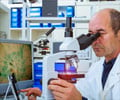U.S. researchers have announced the development of a new kind of microscope that can help visualize cells in three dimensions.
U.S. researchers have announced the development of a new kind of microscope that can help visualize cells in three dimensions.
The researchers say that the technique may bridge a widening gap between cutting edge imaging techniques used in research and clinical practices.Associate Professor Eric Seibel and his colleagues carried out this work in collaboration with a private company called VisionGate, which holds the patents on the technology.
The have revealed that the machine works by rotating the cell under the microscope lens, taking hundreds of pictures per rotation, and then digitally combining them to form a single 3-D image.
According to them, the 3 D visualizations may lead to big advances in early cancer detection, since clinicians today identify cancerous cells by using 2-D pictures to assess the cells' shape and size.
It's a lot easier to spot a misshapen cell if you can see it from all sides. A 2 D representation of a 3 D object is never perfectly accurate imagine trying to get an exact picture of the moon, seeing only one side, Seibel said.
The new microscope is known by the trademarked name Cell CT because it works similarly to a CT scan, though on a very small scale.
Advertisement
In the Cell CT microscope, each cell is embedded in a special gel inside a glass tube that rotates in front of a fixed camera that takes many pictures per rotation.
Advertisement
In both processes, hundreds of pictures are assembled to form a 3D image that can be viewed and rotated on a computer screen.
Scientists have been using fluorescent dyes in research for decades, but these techniques have not yet broken into everyday clinical diagnoses. There's a big gap between the research and clinical worlds when it comes to cancer, and it's getting wider. We're trying to bridge that gap, Seibel said.
According to him, this gap is partly because there is no way to accurately match an image taken using the fluorescent dyes with an image taken using the traditional stains that currently form the basis for cancer diagnoses, and for which diagnostic standards exist.
Seibel says that the new 3 D microscope will allow that match-up, for his team have shown simultaneous fluorescent and traditional staining of the same cells.
He claimed that the new device is the first 3 D microscope that can use both traditional and fluorescent stains.
Now that we have a way to compare these stains, we hope this will provide a way to get some of those sophisticated research techniques into clinical use,Seibel said.
The researcher further claimed that the new microscope was more precise than other 3D machines currently available.
Qin Miao, a UW bioengineering doctoral student, used a tiny plastic particle of known dimensions to show the microscope's resolution, and found it to have three times better accuracy in that up down direction than standard microscopes used in cancer detection.
While making a presentation on the group's findings about the microscope's performance at the SPIE Medical Imaging conference in Orlando, Florida, Miao said: This means we can do quantitative analysis of cells. This kind of undistorted image is difficult to achieve using other technology.
Funding for the project was provided by VisionGate and the Washington Technology Center.
Source-ANI
SPH














